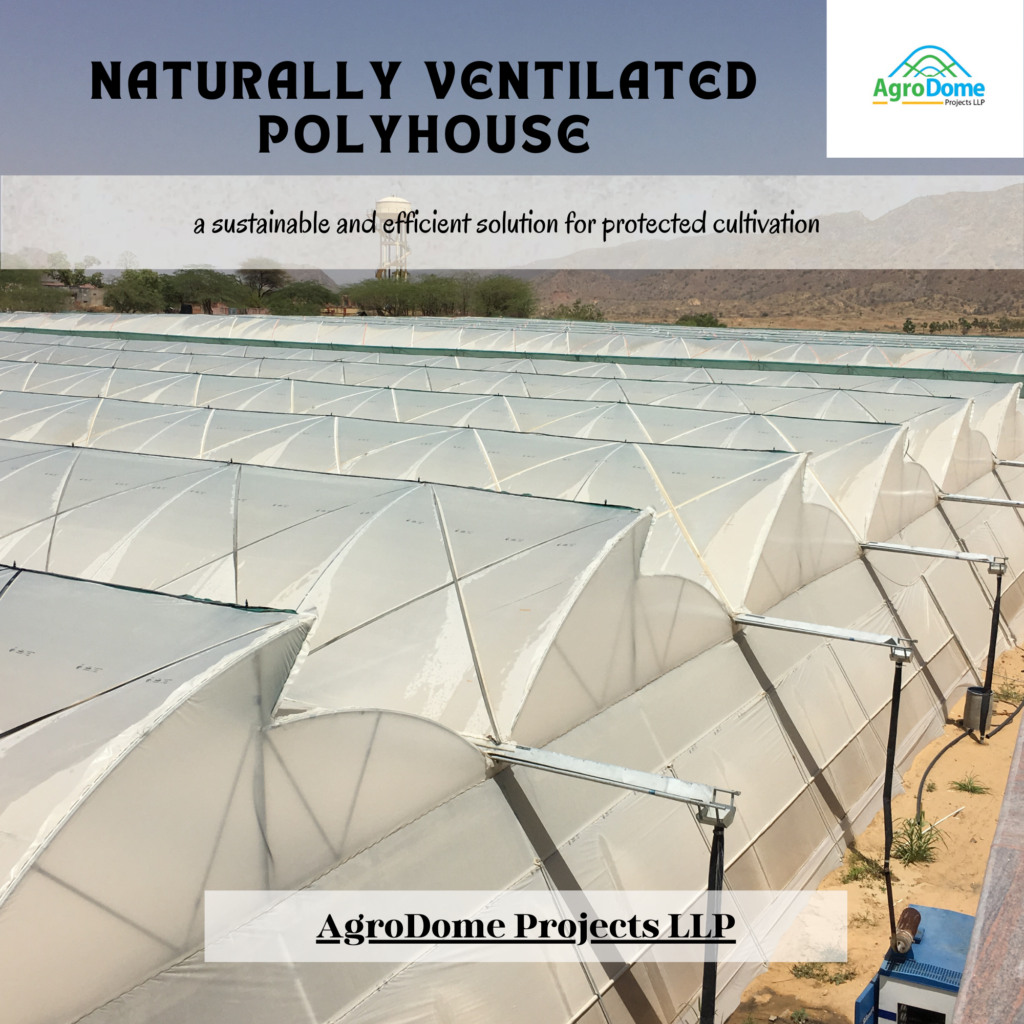In the realms of modern agriculture, protected cultivation methods have revolutionized the way crops are grown, offering a sustainable and efficient approach to maximize yields and quality. Among these methods, naturally ventilated polyhouses stand out as a versatile solution for growers seeking to harness the benefits of controlled environments while minimizing energy consumption and environmental impact.
What is a Naturally Ventilated Polyhouse?
A naturally ventilated poly house, also known as a naturally ventilated greenhouse, is a greenhouse structure designed to harness natural airflow for temperature regulation and climate control. Unlike traditional greenhouses equipped with mechanical ventilation systems, naturally ventilated polyhouses leverage passive ventilation techniques to maintain optimal growing conditions for crops.
Different Names:
- Naturally Ventilated Greenhouses
- Eco-Friendly Polyhouses
- Sustainable Crop Shelters
- Passive Ventilation Enclosures
- Climate-Smart Growing Structures

Discovering the Marvels: Naturally Ventilated Polyhouses
Picture a sanctuary where crops flourish under a canopy of innovation. Naturally ventilated poly houses, also known as eco-friendly polyhouses or climate-smart growing structures, are the architects of this agricultural utopia. Their framework, crafted from robust materials like galvanized steel or aluminum, offers steadfast support and stability. Crowned with polyethylene film or polycarbonate sheets, these shelters welcome sunlight, diffusing its rays to create the perfect ambiance for plant growth.
Technical Specifications:
- Framework: Constructed from durable materials such as galvanized steel or aluminum, the framework of a naturally ventilated poly house provides structural integrity and support for the entire structure.
- Covering Material: High-quality polyethylene film or polycarbonate sheets are commonly used as a covering material for naturally ventilated polyhouses. These materials allow sunlight to penetrate while diffusing light to minimize hotspots and provide uniform illumination.
- Ventilation System: The design of a naturally ventilated polyhouse incorporates features such as roof vents, side vents, or ridge vents to facilitate natural airflow and temperature regulation. These vents are strategically positioned to optimize airflow and create a comfortable microclimate for crop growth.
- Shading System: Optional shading systems may be installed to protect crops from excessive sunlight and reduce heat stress during peak daylight hours. These systems can include shade cloths or retractable screens that can be adjusted based on the intensity of sunlight.

Applications:
- Nursery Cultivation: Naturally ventilated greenhouses are ideal for propagating seeds, seedlings, and young plants, providing a controlled environment for optimal growth and development.
- Tomato Cultivation: Tomatoes thrive in the controlled environment of poly houses, with natural ventilation ensuring proper air circulation and temperature regulation for healthy plant growth and abundant fruit production.
- Capsicum Cultivation: Capsicum plants benefit from the protection and climate control provided by polyhouses, resulting in increased yields of high-quality bell peppers and chili peppers.
- Chili Cultivation: Chili peppers grown in naturally ventilated greenhouses are less susceptible to temperature fluctuations and environmental stressors, leading to improved fruit quality and yield.
- Cucumber Cultivation: Cucumbers grown in polyhouses are shielded from adverse weather conditions and pests, allowing for consistent production and higher marketable yields.
A Symphony of Benefits: Maximizing Crop Yields
- Energy Efficiency: By harnessing natural airflow and sunlight, naturally ventilated polyhouses reduce the reliance on artificial heating and cooling systems, resulting in lower energy consumption and operational costs for growers.
- Improved Crop Quality: The controlled environment provided by naturally ventilated polyhouses promotes healthier plant growth, leading to higher yields and superior quality produce that commands premium prices in the market.
- Climate Resilience: In regions prone to extreme weather conditions such as high temperatures or strong winds, naturally ventilated polyhouses offer protection to crops, reducing the risk of damage and ensuring consistent production year-round.
- Environmental Sustainability: With a reduced carbon footprint compared to conventional greenhouses, naturally ventilated polyhouses align with sustainable farming practices, preserving natural resources and minimizing environmental impact.
- Versatility and Adaptability: Naturally ventilated polyhouses can be customized to accommodate a wide range of crops, from vegetables and fruits to flowers and herbs. Their modular design allows for scalability and adaptability to changing agricultural needs.
Embrace the Future: Cultivate with Purpose
As we embark on this journey through the verdant landscapes of modern agriculture, let us embrace the potential of naturally ventilated polyhouses. They are not just structures; they are the guardians of our crops, the stewards of our land, and the harbingers of a sustainable future. Together, let us cultivate with purpose, guided by the wisdom of innovation and the promise of abundance.







